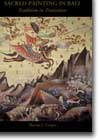| Our Publications | ||
| Books by Title | ||
| Books by Author | ||
| Books by Country | ||
| E-books | ||
| About | ||
| Orchid Press E-books | ||
| Distributed E-books | ||
| Our Bookshop | ||
| About Us | ||
| Browse Shop | ||
| How to Buy | ||
| Contact Us | ||
| WE BUY BOOKS AND LIBRARIES | ||
|
||
Book Reviews

Sacred Painting in Bali:
Tradition in Transition
byThomas L. Cooper
2005. 192 pp., 96 col. pl., 2 maps, bibliography, index, 29 x 21 cm., hardcover.
ISBN-10: 974-524-034-6 $45.00
ISBN-13: 978-974-524-034-6
Book review by Dick Van Der Meij
(Journal of Southeast Asian Studies, June 2007)
Efforts to understand the totality of Balinese traditional paintings are rare and the present book is the most comprehensive to have seen the light so far. Instead of paying attention to the most obvious and well-known traditional paintings and styles of the village of Kamasan near Semarapura (former Klungkung) Cooper looks further and also explores other traditions over the whole of the island. These centres, Kamasan (southeast Bali), Kerambitan (southwest Bali), Batuan and Ubud (south central Bali), and Nagasepaha (North Bali) are discussed in Chapters 4 and 5. The book starts with a lucid introduction to define salient issues when researching these paintings. They should, first, have subject matter derived from a communal body of narrative; second, manifest a communal vision of the unseen world; third, have a religious purpose; fourth, be regarded as sacred; fifth, be stylistically related to shadow puppets; sixth, be regarded as having a specific use, and not considered mere pieces of art. Apart from stylistic features found in the centres of traditional paintings, individual stylistic elements of particular painters may also be identified, many of which are discussed in Chapter 5
Paintings may be made on cloth, bark, or wood and a large number of them are reverse glass paintings. They usually portray scenes of the Mahabharata (especially the first book, the Adiparwa) and other texts from the core of old Javanese literary works (such as kakawin) and poems in Indian or Indian-derived metrical forms (the Arjunawiwaha, Ramayana, Smaradahana, Sutasoma, and Bharatayuddha). Many paintings depict scenes from the extensive Malat and show the prince of Koripan in search of his beloved. Other stories such as the Bima Swarga, Brayut, and other indigenous Balinese are also popular. However, many paintings show a god or goddess without reference to a particular story.
The paintings are made on request and adorn family or community temples or a ceremonial structure in a household compound. Cooper is rather strict on this point as he claims that he only considers paintings to be traditional when they are found in situ in one of these places. This sits awkwardly with the traditional paintings he portrays from his own and other collections as they are clearly not found in situ and the precise nature of their origins is often not indicated. This standpoint is also too strict, as sometimes a painting can only be understood by reference to paintings in museums or private collections.
The most important observation Cooper makes is that these paintings are not pieces of art to be admired and cherished but utensils of piety. They depict highly sacred subjects and are consecrated with the proper rituals after having been put in place. They are also not obligatory but optional and are highly venerated by people. They may fade over time, and when a painting can no longer be used it may be burned or stored to decay accompanied by the necessary rituals as they never lose their sacred power.
The link Cooper makes between paintings and the (wayang) shadow theatre is interesting, although I wonder which came first. The subjects portrayed in paintings are usually similar to their corresponding wayang figures and similar depictions are found -in much the same way - in stone friezes on temple walls. Wayang is performed regularly so that painters are easily familiar with iconographic and narrative particulars.
The presupposed Indian ancestral roots to Balinese paintings I find confusing. On the one hand, he claims that narrative painting came to Java and Bali from India while on the same page he states that no paintings are found in India that are demonstrably ancestral to those of Bali (p. 22). The similarities rest on the assumption that the subject matter is derived from sacred narrative, that the figures are highly stylised, that characters are depicted as stereotypes and are identified by formal attributes. I find this unconvincing as these characteristics are also found in other parts of Asia and indeed in early European painting.
The book is lavishly illustrated with full colour photos of paintings from collections all over the world but mostly taken at the locations where the paintings are kept. This gives the book a dimension of authenticity; the paintings and their surroundings are now combined instead of separated. His approach to his research is simple. Instead of making elaborate plans, Cooper approached his project by ‘walking around in Balinese villages and talking to people’ (p. 11)
[Read a review from American Anthropologist] [Read a review from Anthropos] [Read a review from the Asian Folklore Studies, Nanzan University, Nagoya] [Read a review from the Journal of Folklore Research, Indiana University] [More Orchid Press Reviews]
PO Box 70, Trinity TB, NL, A0C 2S0, Canada
Telephone: +1 709-330-4703